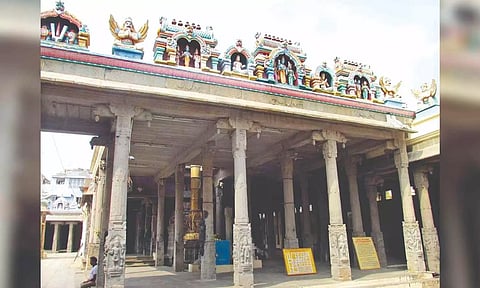

CHENNAI: There is no paucity for temples, old or new, in Chennai today. Some of its temples are from Pallava, Chola, and Vijayanagar times, and have been sanctified with songs by the alwars and the nayanmars.
But one temple is very important for Madras. The Chenna Kesava temple, was built within the first year of the inception of Madras, and by one of its founders – the dubash Beri Thimmappa.
The twin tongue dubash Thimmappa, brokered and sealed the agreement between the Poonamalle Nayaks, and the East India Company.
While Fort St. George was being built, simultaneous planning was entrusted to Thimmappa, to build residential quarters for the Indian associates of the East India company. Workers were assigned to build the fort, and weavers to supply them clothes for export. The Indians settled to the north of the fort, forming the famous black town.
Here was, the yet to be named Cooum, on the south side of the fort. And so, Thimmappa decided that the Indians would live to the north of the fort, all around a temple he planned to construct. It was within this temple, that Chenna Kesava, a form of Vishnu, was installed. There are many other old temples across the Vijayanagar empire, that have the same name.
Was this great town pagoda (temple) derived out of piety and faith, or was it a convenient addition to a town to attract people to come and settle? Only Beri would know.
Chenna Kesava was the first temple to be built in Madras, as we know it today. The first citizens of this city worshipped here. Perhaps, for a decade, those who were not allowed into temples, back in the villages, could go into one and meet god. But, the idangai and valangai inter-caste riots must have put an end to it.
Still the temple flourished. And within a decade, it was mentioned in East India Company records, and correspondence. Temples were thereafter used in Chintadripet and Colletpet, which the company founded later, as a magnet to attract migration.
A century ran by, the temple, the fort, and the trade, flourished. The last two attracted the invaders eyes. The French under Dupleix, would invade and bomb the fort into submission. For three years, the French tricolor flew over the fort.
But, political events happening far away, could have the ripple effect. When the next heir to the Austrian throne was being decided by all the powers of Europe sitting in Aachen Germany, they decided, as a goodwill gesture, that all the participants will return what they had conquered from another. So Madras came back to the British, instead of a still sleepy Canadian town.
The British was held up in Cuddalore fort St. David, and made some introspection on how they had lost their prized fort. They decided that it was because of the black town, which had grown uncontrollably around them, and holding them in a deathly embrace.
When they got back Madras, the first thing they did was, mark new territory for the natives beyond an open space called, Esplanade in medieval combat terms. The space would give a clear firing line, and also make the foe visible even at a distance. They marked obelisks, and warned Indians that, they could encroach beyond, only at the peril of punishment. They knocked off the whole of the black town, but hesitated, when they had to touch the Perumal temple. Would people revolt? Or walk away en masse to Santhome as they had once done?
The company still depended on dubashes for advice and mediation. Muthu Krishna mudaliar, the chief merchant of the company, offered a solution. Space and money to build two temples far away, would soften the blow, he said. And the company agreed. Though they gave less than a tenth of the money used ( 15,000 pagoda coins), the land a mile away was free.
There was no murmur, and the thankful people even called it the Company pagoda for over a century. As agreed, the Perumal, a new shiva temple, and a pond was moved to 24,000 square feet space. Muthu Krishna, and other donors pooled in much, and are remembered on the temple pillars, as bas reliefs. After 13 years of work, Chenna Kesava, perhaps in safekeeping, was moved to his new home. Hundreds of temples would come up in the black town, so much, that their donation drives were considered harmful to society, and the company even banned it for sometime.
So, what is there, where Chenna Kesava once stood? The esplanade, when warfare methods changed, and the ranks of enemies thinned , was considered an awful waste of space, next to the government’s seat.
A century after Chenna Kesava moved out, queen Victoria sanctioned a court for Madras, a part of the High Court of Madras, stands exactly where the temple was situated.
Kesava, accompanied by his brother in law Mallikeshwara, reside a mile away. The temples are surrounded by four mada streets meant for the chariot movement, and a temple pond as well. The mada streets were called by their directions before other names were given.
Once during Tipu sultans invasion, the metal utsava idol was shifted to Thiruneermalai, a hilltop temple. A decade later, when brought back, it is often rumoured, that by mistake the idols got switched.